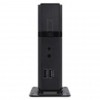ViewSonic SC-T35 SC-T35 / SC-T45 ViewSonic Device Management (English) - Page 25
Deleting Thin Client Firmware Files, Scanning Thin Client Firmware Files
 |
View all ViewSonic SC-T35 manuals
Add to My Manuals
Save this manual to your list of manuals |
Page 25 highlights
Using ViewSonic Device Manager Establishing a Basic Administration Environment 6. Click Import to start importing the selected firmware file. 7. On completion, the imported firmware file appears as an entry in the Firmware list. Deleting Thin Client Firmware Files To delete a thin client firmware file, please do the following: 1. On System tab, click Deployment > Firmware. 2. The Firmware list appears in Management area. 3. Click to select the desired firmware file, and then click Delete Firmware on the top of the Firmware list. NOTE • To delete more than one firmware file, Ctrl-click to select multiple files. 4. The Delete Firmware window appears prompting you for confirmation. 5. Click Delete to confirm. 6. On completion, the selected firmware file is removed from the Firmware list. Scanning Thin Client Firmware Files The Scan Firmware feature helps you to discover the local or remote firmware files. There are two scenarios that you need the help of this feature. The first scenario is that you choose to update clients with remote firmware files rather than local imported ones. In this scenario, the local list of available firmware in ViewSonic Device Manager may be not in sync with the remote list of firmware files on another computer where you choose to get firmware files. The Scan Firmware feature can synchronize your local list with the remote one. NOTE • For instructions on how to configure your ViewSonic Device Manager to use remote firmware files on another computer for client management, please refer to section "3.2.7 Configuring Remote Deployment Settings" on page 26. 20















